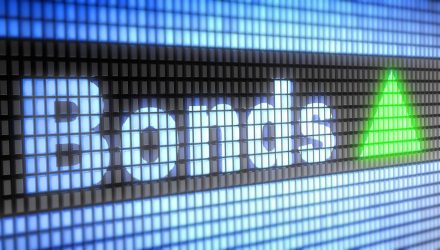While some are moving away from speculative-grade debt with lower credit ratings in a heightened risk-off environment, income-minded investors can still look to targeted junk bond exchange traded fund strategies that steer toward high-yield debt with a little less credit risk.
According to ICE BofAML data, the spread between the most speculative-grade triple-C rated bonds has increased to around 8 percentage points over higher-rated double-B bonds, the widest since November 2016, the Wall Street Journal reports.
John Lloyd, co-head of global credit research at Janus Henderson, pointed out that greater uncertainty about the economy has pushed investors to bonds of companies that are better positioned to survive a downturn or debt with lower credit risk.
“People would rather be safe than sorry,” Lloyd told the WSJ. “They’re acting cautious.”
Chris Kocinski, a bond portfolio manager at Neuberger Berman, also highlighted greater risks within the energy and healthcare space due to cash flow issues.
“Energy issuers are facing idiosyncratic as well as macro concerns regarding global growth,” while health-care companies have risks related to changing reimbursement rates and are under the microscope as election season quickly comes up, Kocinski told the WSJ.
Meanwhile, the downtrodden triple-C bonds have taken an even heavier beating this month after investors’ broad aversion to risk as well as company-specific problems.
Looking ahead, as corporate earnings start to decline and economic data starts to weaken, “downgrades and defaults usually follow,” Matthew Eagan, a bond fund manager at Loomis, Sayles & Co., told the WSJ.
Nevertheless, investors who are looking for higher yielding strategies can still look to junk-related bond ETFs that tilt toward higher credit qualities.
For example, the VanEck Fallen Angel High Yield Bond ETF (NYSEArca: ANGL) was the first ETF to provide exposure to “fallen angel” bonds, speculative-grade debt securities that were initially issued with an investment-grade rating but were later downgraded to junk territory. Fallen angel issuers tend to be larger and more established than many other junk bond issuers.
Since these fallen angels were formerly on the cusp of investment-grade status, the group of junk bonds typically has a higher average credit quality than many other speculative-grade debt-related funds. The higher average quality also helped absorb some of the market volatility we experienced last year.
The fallen angel ETF’s credit profile includes BB 75.5%, B 16.7%, CCC 5.4% and CC 0.8%, leaning toward the upper-end of the speculative-grade debt spectrum.
Similarly, the iShares U.S. Fallen Angels USD Bond ETF (NASDAQ: FALN) tracks the Bloomberg Barclays US High Yield Fallen Angel 3% Capped Index composed of U.S. dollar-denominated, high yield corporate bonds that were previously rated investment grade.
FALN’s credit profile includes BB 73.7%, B 16.7%, CCC 7.4% and CC 0.7%.
Additionally, something like the Xtrackers Low Beta High Yield Bond ETF (NYSEArca: HYDW) can help investors reduce the risk they are comfortable with in the high-yield segment. The Xtrackers Low Beta High Yield Bond ETF tries to reflect the performance of the Solactive USD High Yield Corporates Total Market Low Beta Index, which includes junk-rated debt that exhibits lower overall beta to the broader high-yield bond market. Consequently, the portfolio is comprised of lower-yielding junk bonds that show a lower beta.
HYDW includes a credit profile of 1.3% AAA-rated bonds, 2.0% BBB, 74.5% BB, 21.6% B and 0.7% CCC.
For more information on the fixed-income market, visit our bond ETFs category.







